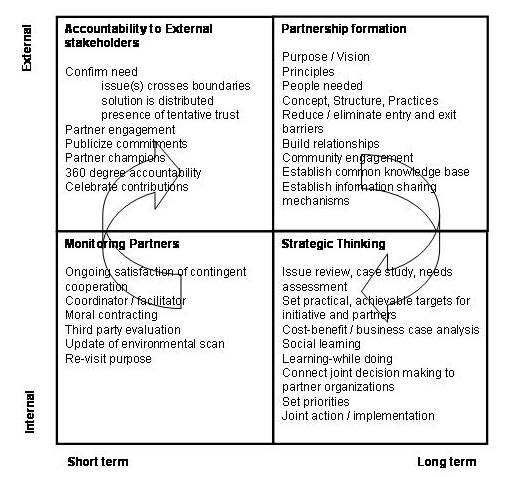
Working Better Together: Resolving Collaboration & Partnership Issues
Back
Issue
Strategy
Steps
Maintain Trust
Understand the risks & rewards for each participating partner
 |
||
Working Better Together: Resolving Collaboration & Partnership Issues |
||
BackIssue |
|
|
| Can't do it alone |
Recognizing that the issue(s)
crosses the boundaries of several organizations |
Listen and document how issue
affects different organizations in different ways |
| Conduct an invitation
conversation |
||
| Accepting a distributed solution
|
Recognizing knowledge is
distributed |
|
| Recognizing resources are
distributed |
||
| Recognizing mandates/ or
authority is distributed |
||
| Identifying who needs to be
involved and what they might contribute |
||
| Governance becomes
distributed - no one is in control |
||
| Engage potential partners and stakeholders & bring them to table | Conduct posibility conversation
& explore nature of issue & possible futures |
|
| Engage in relationship building |
||
| Establish ground rules necessary
for everyone to
participate - purpose, principles, people, concepts, structures &
practices |
||
| Consider who to include: Who has
power to make it happen? Who can stop it? Who has relevant knowledge?
Who is impacted or at risk from decisions that might be made? |
||
| Partners go public with their
commitment to work together |
||
| Build & Maintain Trust |
Secure an initial basis of trust |
Reduce or eliminate entry and
exit barriers Understand the risks & rewards for each participating partner |
| Do your due diligence but
understand the 'person' you'll be working with. That may mean spending
some time together. |
||
| What 'hooks' can be offered?
Potential benefits identified |
||
| Need to re-affirm relationships of trust | Share respective impacts of issue |
|
| Meet periodically to confirm
shared goals & understandings and confirm any changed
organizational operating contexts. The more interdependent you
are, the more
frequent should be these meetings. |
||
| Ongoing sharing of
organizational knowledge and insights |
||
| Need to satisfy contingent
cooperation |
Establish mechanisms for
transparency & information
flow. Define progress measures of both the results of your work and how
you are together. |
|
| Establish practical, achieveable
targets for each partner |
||
| Create governance structure |
Prepare a distributed governance
model |
|
| Collective
Learning |
Establish common knowledge base |
Preparation of state of issue
review, cases,
needs assessment or studies. Determine what information partners
require to make a decision. |
| How are stakeholders
contributing to the status quo of the issue? |
||
| What metaphors / frames are in
use by stakeholders? |
||
| Can these frames be reconciled? |
||
| Use your work together as a learning tool. Start with small things to build confidence in your mutual understanding & your relative abilities. | ||
| Engage in meaning making |
Enagage in facilitated sessions,
where interpretation of study results done jointly |
|
| Establish relevance and
priorities |
Establish priorities by consensus |
|
| Collective
Decision Making |
Establish how collective
decisions will be made among partners |
Consensus is best, although a backup alternative should be established in case consensus is not achievable |
| Establish how will collective decisions be transferred to home organizations? | ||
| Addressing multiple
accountabilities |
Establish the relastionship
between
the collaborative body and participating organizations |
|
| Who is accountable to whom and
how? |
||
| Is decision making authority
sufficiently delegated? |
||
| Identifying power imbalances |
There is no such thing as
'almost equal'. Mitigate any inequalities |
|
| Collective Action |
Address free-rider tendency |
Establish champions for horizontal communication |
| Establish regular feedback
mechanisms for exchanging information |
||
| Establish partner commitments |
Publicize commitment |
|
| Ongoing partner management |
||
| Identify partner benefits/ value
added from joint work |
||
| Recognize achievements |
||
| Monitoring &
Evaluation |
Identify assessment and evaluation mechanisms | Prepare at minimum a report
annually and at
end of project and, if possible, using of third party evaluators |
| Re-evaluate your environment and
project's relevance to it |
||
| Evaluate the continued need for
collective action -- is the project still needed, can it be done by
others, should it be done by others, can we afford it, can it be spun
off? |
||
